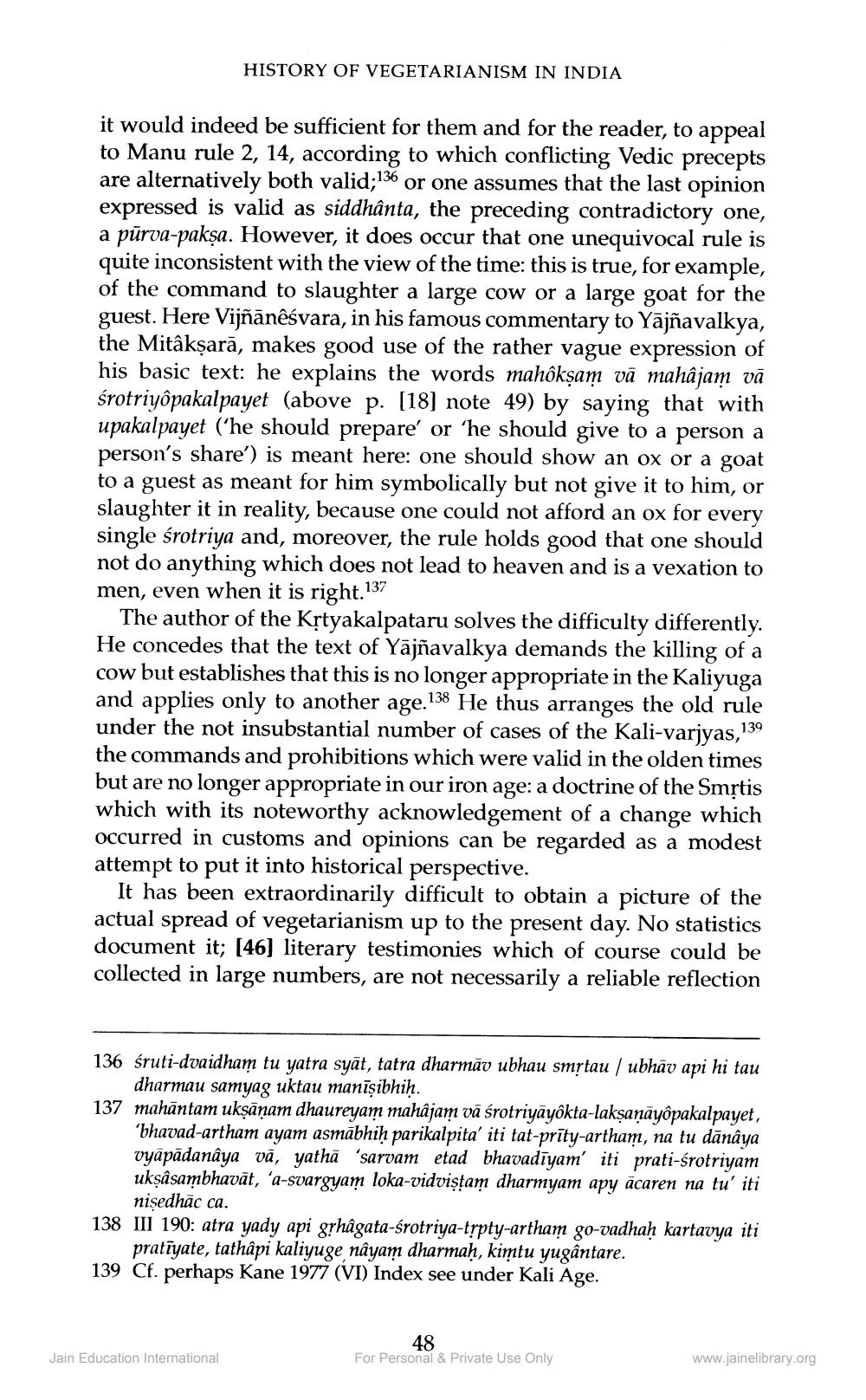________________
HISTORY OF VEGETARIANISM IN INDIA
it would indeed be sufficient for them and for the reader, to appeal to Manu rule 2, 14, according to which conflicting Vedic precepts are alternatively both valid;136 or one assumes that the last opinion expressed is valid as siddhanta, the preceding contradictory one, a pūrva-pakşa. However, it does occur that one unequivocal rule is quite inconsistent with the view of the time: this is true, for example, of the command to slaughter a large cow or a large goat for the guest. Here Vijñānêśvara, in his famous commentary to Yājñavalkya, the Mitâkṣarā, makes good use of the rather vague expression of his basic text: he explains the words mahôkşam vā mahâjam vā śrotriyôpakalpayet (above p. [18] note 49) by saying that with upakalpayet ('he should prepare' or 'he should give to a person a person's share') is meant here: one should show an ox or a goat to a guest as meant for him symbolically but not give it to him, or slaughter it in reality, because one could not afford an ox for every single śrotriya and, moreover, the rule holds good that one should not do anything which does not lead to heaven and is a vexation to men, even when it is right. 137
The author of the Krtyakalpataru solves the difficulty differently. He concedes that the text of Yājñavalkya demands the killing of a cow but establishes that this is no longer appropriate in the Kaliyuga and applies only to another age. 138 He thus arranges the old rule under the not insubstantial number of cases of the Kali-varjyas,139 the commands and prohibitions which were valid in the olden times but are no longer appropriate in our iron age: a doctrine of the Smộtis which with its noteworthy acknowledgement of a change which occurred in customs and opinions can be regarded as a modest attempt to put it into historical perspective.
It has been extraordinarily difficult to obtain a picture of the actual spread of vegetarianism up to the present day. No statistics document it; [46] literary testimonies which of course could be collected in large numbers, are not necessarily a reliable reflection
136 śruti-dvaidham tu yatra syāt, tatra dharmāv ubhau smrtau ubhāv api hi tau
dharmau samyag uktau manīşibhiḥ. 137 mahāntam uksānam dhaureyam mahâjam vā śrotriyāyôkta-laksaņāyôpakalpayet,
'bhavad-artham ayam asmābhiḥ parikalpita' iti tat-prīty-artham, na tu dānâya vyāpādanâya vā, yathā 'sarvam etad bhavadīyam' iti prati-śrotriyam ukşâsambhavāt, 'a-svargyam loka-vidviştam dharmyam apy ācaren na tu' iti
nişedhāc ca. 138 III 190: atra yady api gļhâgata-śrotriya-typty-artham go-vadhaḥ kartavya iti
pratīyate, tathâpi kaliyuge nayam dharmaḥ, kimtu yugântare. 139 Cf. perhaps Kane 1977 (VI) Index see under Kali Age.
48 For Personal & Private Use Only
Jain Education International
www.jainelibrary.org




